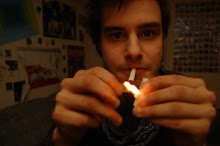Written for Professor Norton McNulty's Feature Writing Class
Fall '09 - SUNY New Paltz
He stays up all night producing hip hop beats on his laptop and spends afternoons playing acoustic guitar and singing with friends. For 24-year-old SUNY New Paltz graduate student Dan Morgenstern, music is a job, a hobby, and an integral part of life.
After earning a bachelor’s degree in contemporary music studies from New Paltz, Morgenstern enrolled in the music therapy master’s program and began cultivating his career. He currently interns at ELANT Health and Housing Solutions in Newburgh performing music therapy with patients suffering from social and behavioral disorders.
Through playing music with friends and using music as a healing tool at work, Morgenstern has developed a unique perspective on the medium.
“What is music? Music is Kool Keith - music is birds and bowling alleys - music is sugar cakes and corn flakes. No… music is sounds - music is essential like blood pumping in your veins. If you look at Kate Moriarty’s art you will see music.”
Morgenstern couples this perspective with professional training in accordance with the American Music Therapy Association’s vision. The association’s website says that music therapy is “an established healthcare profession that uses music to address physical, emotional, cognitive, and social needs of individuals of all ages.”
According to Morgenstern, music therapy can be used in place of or in conjunction with medication.
Both the United States Center for Disease Control and Prevention and the National Institutes of Health recognize music therapy as an accepted treatment for certain neurological conditions.
A National Institute of Mental Health report said that Autism Spectrum Disorders, neural conditions that hinder social interactions and verbal and nonverbal, can be treated by behavioral and communicatory approaches - like music therapy - or with medication like Prozac or Zoloft.
According to the United States Food and Drug Administration, side effects of Prozac include seizures and mania - side effects of Zoloft include nausea, diarrhea, and tremors.
Mary Boyle, chair of the music therapy department at New Paltz said that music therapy is only known to induce positive side-effects.
“Often in therapy we talk about collateral effects, which are positive side effects,” said Boyle. “Music may elevate a client's mood and the client may be able to perform better in several spheres.”
“In my own case music has replaced medication,” Morgenstern added.
At ELANT, Morgenstern helps patients with conditions like Alzheimer’s and dementia with respect to cognition, social interactions, spirituality, emotions and overall quality of life. He said that listening activities for relaxation and active musical participation are beneficial to patients.
One patient, a women with severe dementia developed an uncontrollable tick due to the intense antipsychotics she was prescribed. After working with Morgenstern, she replaced a violent clicking noise with improvisational jazz singing.
“During sessions I would get here to scat sing so she would stop clicking,” he said. “I would start singing to her, she’d join… and it seemed to bring her to a more relaxed state of being.”
Morgenstern has been a musician since he could “bang on the pots” in his mother’s kitchen and is overwhelmed each time he witnesses healing power of music.
“It makes me feel great… like I’m accomplishing something real,” he said.
He currently accepts music as his personal therapeutic catalyst by making hip hop beats and recording rap songs in his cluttered one-room apartment. His floor is scattered with digital drum machines, microphones, effects pedals and wires that lead to seemingly unknown terminals.
Morgenstern described the music he makes as a “waste of time” - however it means the world to him.
When asked to elaborate on his music, he paused and became noticeably pensive.
“I play what I want to hear,” he said. “Hip hop music makes you feel so cool. You can just… dance… and everybody looks cool because there’s music goin’ on in your head. Everybody’s so happy… and crazy.”
Morgenstern did not align his love for music with the health field until college. After he discovered music therapy, Morgenstern began appreciating the growing importance of the discipline as well as its personal benefits.
“[Music therapy] can help anybody from burn victims… to people with autism… to people just recovering from any sort of psychological disorder,” he said. “… I get high off their smiles.”
Morgenstern hopes to someday own a private music therapy practice integrating his love for recording with a newfound desire to help at-risk children.
“I feel like I can utilize hip hop… you know, provide recording time to build self esteem and self-accomplishment,” he said. “It’d be so great to teach kids songs then allow them to record or just write songs with them.”
Morgenstern’s current recording setup is modest to say the least. A Kustom KGA 10 watt guitar amp is fed directly to his Macbook. He also wires three digital delay pedals with a Doctor Rhythm DR 770 drum machine and vocals are run through a Radio Shack dynamic microphone.
Morgenstern’s equipment cost him about $2,000 - he hopes to upgrade in the near future.
At the end of a two hour interview accompanied by background music ranging from contemporary jazz to 80’s hip hop, Morgenstern apprehensively said “Make sure you understand that my favorite thing to do is…” he paused. “My favorite thing to do is walk around and listen to music. It just makes me feel really cool.”
Tuesday, December 15, 2009
Subscribe to:
Post Comments (Atom)

No comments:
Post a Comment